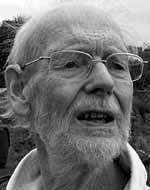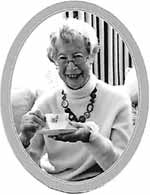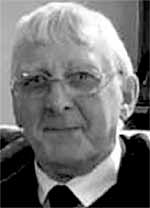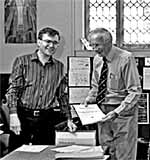News
From the Chair of Council
As we all move cautiously towards our post-COVID ‘normality’, the Society looks forward to resuming its characteristic pattern of events, excursions, and lectures. As you might expect, we are making these plans sensibly and with an eye to unfolding events. It has not proved possible to proceed with our ‘Special Event’ - a concert by the Lincoln Waites originally scheduled for June 2020, which we have once again postponed for this year. However, we are pleased to announce an additional online event for Saturday 26 June. John Beckett’s valedictory lecture at the University of Nottingham, which was originally to be delivered as the Cust Lecture for 2020, will now be held online, as a co-partnership event with the Society. Booking details can be found later in the newsletter. This should provide a memorable and fitting recognition of John’s service both to the University and the Society over some four decades. Likewise, we will be paying tribute to John, and to Barbara Cast, as we originally intended to do during 2020, at our re-scheduled Annual Lunch in November. Fingers crossed!
The Society is looking ahead to its 125th anniversary commemorations in 2022. An important part of this involves progressing the digitisation of our Transactions and past issues of the Newsletter. Any member of the Society who might have early issues of Transactions which they would be willing to let the Society have for this purpose are invited to get in touch with me (see my contact details on the inside back cover). We hope this will grow into a valuable resource commemorating the Society’s role in advancing scholarship over the course of its 125 years. The Society’s Council has recently considered changes to the format of the newsletter, in order to maintain its quality and significance whilst keeping a sensible eye on costs. As such, this will be the last newsletter to appear in its current format. The next issue will be the first to appear as an A5 booklet with colour covers, thereby bringing it into line with the style of our existing Annual Reports. The Annual Report will effectively become the spring newsletter each year, containing not only the usual information and updates on the work of the Society but a small number of articles relevant to the venue for our Spring Meeting. The newsletter continues to be edited expertly by Paul Baker, to whom we remain extremely grateful. I am pleased to announce that Hannah Nicholson will be joining Paul from the next issue as assistant editor, to help with the production process. We hope that these changes will ensure the continuation of the hard-copy newsletter, which we know is valued so highly by members. However, if anyone would prefer to receive the newsletter electronically, as a PDF file, please do let Paul know.
I hope that this newsletter finds you safe and well and looking forward to the resumption of some sort of ‘normality’ in your lives.
Richard Gaunt
Obituaries
Leslie Cram (1942-2021)

Members will be sad to hear of the death of (Charles) Leslie Cram, who served the Society as Honorary Programme Secretary 2004-2010. He passed away on 7 February 2021, aged 78, at Scalford Court Care Home. Leslie was born in Vancouver, Canada, on 18 May 1942, the son of Methodist missionaries to China whose journey back to England on furlough had been interrupted by wartime events. After a further period in China, the family returned to the Midlands, where his father served in the Methodist Church in Grantham, Hucknall, Bingham and Long Clawson before retiring to Harby, Leicestershire. Leslie was educated at Kingswood School, Bath and went on to study archaeology and anthropology at Peterhouse, Cambridge, where he specialised in the Old Stone Age with a particular interest in the analysis of animal bones and stone tools. After a short period of employment at the British Museum, he became Principal Curator for the museum service of Reading Borough Council, where he took care of the special collections of Thames Valley hand axes, Mesolithic Thatcham, Roman Silchester and the ruined remains of Reading Abbey. While in this post he was involved in archaeology and planning, sites and monuments records, rescue archaeology and excavation units. He also arranged lectures and excursions, working with the Berkshire Archaeological Society and Reading University Continuing Education Department. After his retirement he moved to Harby, and soon began work on sorting and cataloguing his own family papers. The Cram archive, covering the family's origins in North Kelsey as well as his parents' experiences in China and amounting to 43 boxes of documents and 20 files of photographs, was deposited in Lincolnshire Archives. Leslie then helped to form the Harby History Group, and on its behalf collected photographs, personal papers and other historical materials about the village. His digital copies of these records became the basis for the Harby History website which he maintained and later transmitted for permanent preservation and access to the British Library's UK Web Archive, the originals being transferred to the Record Office in Leicester. Leslie edited the History Group's two publications, Harby: Village Life in the Vale of Belvoir (2010) and Harby in the Vale of Belvoir 1975-2014 (2014) and he himself wrote an historical guide to St Mary's Church, Harby (2012).
Leslie joined the Thoroton Society soon after he retired. He enjoyed its combination of field archaeology and historical research, and admired its success in providing news from recent digs and informing local historical understanding through talks, outings and publications. When he assumed responsibility for its programme of events, he built on his earlier experience in Berkshire, aiming to offer a balance of talks that would meet the diverse interests and backgrounds of Society members. Leslie wore his expertise lightly, but he was an excellent companion to have on a local walk, making observations informed both by his knowledge of landscape and its history and by his acute artistic eye. Although in recent years his mobility was limited and he was unable to attend Thoroton meetings, he maintained a close interest in its events.
Richard Gaunt
Mary Greatorex (1928 - 2021)

Mary Greatorex and her husband Stan, who died 4 years ago, were regular attenders at both the winter lecture series and the summer excursions. Mary was born in Radcliffe on Trent and had a number of jobs before she and Stan married in 1951 and settled in Sherwood. Stan worked in transport, and Mary for the East Midlands Gas Board. In 1964 they moved to Wollaton, to a house in which they lived the rest of their lives.
They both retired by the mid-1980s and became passionate gardeners. They belonged to garden clubs, Probus clubs, and - for more than thirty years - the Thoroton Society. Stan was also treasurer of the local National Trust, as a result of which they attended a Buckingham Palace Garden Party and met Her Majesty The Queen. Mary too became involved with ‘Riding for the Disabled’.
John Beckett
Ivan Morrell (1945 - 2021)

The eldest of 3 brothers, Ivan from an early age, loved to help care for his two younger siblings and they always shared a fine brotherly bond. Ivan excelled at Maths and Engineering at school and college and worked up to the position of Engineering Manager at the Nottingham Royal Ordnance Factory. He married Audrey, the love of his life, in March 1968 and they lived happily in Beeston Rylands until Audrey’s death in 2018.
Of all the varied interests Ivan followed in his life - gardening, fishing, ornithology, the natural world, rugby union, Nottingham Forest, arranging family get-togethers - his main personal interest was local history, in particular the Anglo-Saxon period. He loved sharing information with like-minded local historians and produced evidence through his other talents, in-depth research and problem solving. Ivan is survived by his son Paul and two grandchildren, Callum & Sian.
John Wilson
Cynthia Roberta Whitt (1933 - 2021)
Cynthia died peacefully in her own home of a cardiac arrest on 25 January. She was born and educated in Nottingham and gained a diploma in Institutional Management at Gloucestershire Training College of Domestic Science. She had worked in various administrative posts before retiring from the Education Department of Southwell Diocese. In retirement she served as a volunteer on Nottingham Cancer Research Committee, was a member of Nottingham Arts Society and was a keen and loyal member of the Thoroton Society.
Gillian Short
David Bagley (1931-2021)

The Society was saddened to learn of the death, on 27 March at the age of 90, of David Bagley. David became a member of Council in 1994 and succeeded Ann Hoskins as Circulation Secretary the following year, adding publicity and press liaison to his remit in 2000. It was largely thanks to David’s meticulous organisation and hard work that the distribution of mailings to members - not least the annual Transactions - was accomplished so efficiently. David continued in this role until his retirement in 2017, when he was elected one of the Society’s Vice-Presidents. David lived in Woodborough and was closely involved with the work of Woodborough Local History Society. He shared his extensive knowledge of the village with Thoroton Society members at events and in the Newsletter over many years. In May 1997, David spoke at the Society’s half-day school on the 1609 Forest Map, showing how the present appearance of Woodborough compared with the pre-enclosure map, as well as exploring the development of the village, the church, and its local families. At the Millennium, Woodborough Local History Society received £5,000 from the National Lottery ‘Awards for All’ programme for equipment to digitise their collection of local heritage materials, including photographs, maps, and other documents, and to undertake a programme of oral history interviews and contemporary photographic recording of buildings and local scenes. The project was the basis for a decade of work, resulting in an extensive website of local heritage resources (www.woodborough-heritage.org.uk/), which David introduced to Society members in 2011 (see Newsletter 65, Autumn 2011). Two years earlier, Woodborough hosted the Society’s AGM; the event was described by Barbara Cast at the time as vying for the title of ‘one of the best’. It was enlivened by David’s typically insightful illustrated history of the village and his guided tour of the Church of St Swithun - ‘one of three of this name in the county but the only one so spelled’ (report in Newsletter 56, Summer 2009).David was a much-valued member of Council who made a crucial contribution to the work of the Society for more than two decades. The range of his interests, and the breadth of his knowledge, was hidden by a quiet and modest demeanour and a wry sense of humour. He is survived by his wife, Margaret, and daughter, Alison, to whom we extend our sincerest condolences.
Richard A. Gaunt.
(With thanks to Andy Nicholson for locating David’s contributions to the Newsletter.)
Research Awards 2021
Can I remind researchers that awards are available for people undertaking research into Nottingham and Nottinghamshire archaeology or history. Applications are invited from individuals or societies and these will need to be sent to the Honorary Secretary of the Thoroton Society by 1 September 2021 at: barbaracast@btinternet.com
Details of the terms and conditions are available on the Thoroton website.
Barbara Cast
Thoroton Newsletters online
Issues 1-80 of the Thoroton Newsletter, chronicling 23 years of the Society’s activities from 1992 to 2015, have been digitised and are now available to view on our website. They are all searchable so once you have an issue loaded in your browser just press Ctrl-F and type in a search term. The link to the newsletters is here: www.thorotonsociety.org.uk/publications/newsletters.htm
Andy Nicholson
John Hess reports on the Trent Bridge Heritage Team’s work.
‘Covid and Cricket’
It was towards the end of our latest Zoom meetings, we all smiled...and talked with excitement about the hopes for the cricket season of 2021. Since last June, our small group (volunteers with the Trent Bridge Heritage team) have been involved in a ‘once in a life-time’ project.gathering a unique collection of interviews, documents and photographs - even face-masks - that records how cricket coped with the impact of the Covid-19 pandemic. Some of our “Cricket and Covid” stories reflect the personal difficulties many people experienced, but also celebrate the resilience of players, volunteers, and lovers of cricket at all levels in the professional and the recreational game. With more than 110 interviews written up by the end of 2020, the Heritage team could reflect on what’s been achieved. ‘When we started in June, it was genuinely thought that there would be no cricket at all’ was a comment from Peter Smith, a retired journalist, who like me got involved in the project. We had no idea that some 30 weeks later we would still be meeting on Zoom. The initial aim was to create an archive for future cricket lovers and historians wanting to research the impact of Covid-19 on the game. It was also a desire to keep the Heritage volunteers involved while locked down and during an absence of cricket.The Heritage team had done a project a few years ago on the use of Trent Bridge Pavilion as a convalescence hospital during the First World War. But Mike McNamara - one of the longest serving Heritage volunteers - had been frustrated at the lack of first-hand accounts. So in the middle of the first lockdown, the ‘Cricket and Covid’ project was set up.’There is a uniqueness to this’, Steve Le Mottee, Trent Bridge’s Heritage Officer reported . ‘No other county cricket club appears to be undertaking such an exercise, and we are not aware of an equivalent in any other sport’. The value of what has been collated and collected will be very significant nationally. The archive includes the thoughts of Notts stars - such as Stuart Broad and club captain Steven Mullaney - from the first lockdown to the early glimpse of a return to playing cricket behind closed doors. First-hand accounts by club staff add their unique insight and interviews published by the club’s own website have also been included, together with a selection of social media postings by players. But it’s the depth and range of personal stories from across the wider Nottinghamshire cricket “family” that is impressive, from the recreational, youth and women’s game, to bat manufacturers and local businesses, who’ve struggled with the lack of the regular Trent Bridge crowds. And some common themes have emerged, according to Heritage volunteer and oral historian Samantha Ball.The brief was to ask people to help make history, but it quickly became apparent that Trent Bridge means more than just cricket. It also means friendship and a sense of belonging. In the early lockdown, common themes, while missing family and cricket, were gardening and watching movies on Netflix, but that was followed by story after story of resilience and how cricket can react quickly, adapt and change when it needs to.The interviews and the entire project were done in real time. It wasn’t a case of having to catch up and recall memories months after the event. The collection also charts the language of Covid...the bubble, biosecurity hand sanitizing, and the signage and safety protocols that eventually enabled cricket to resume late in the summer. Some of the interviews highlight initial concerns about the long-term prospects for the game among the recreational players. Finding enough volunteers or players for a Sunday match, and worries about a shortage of revenue, appeared to overshadow a lively debate about “cricket teas”. What is also clear from the interviews is a recognition of how the English and Welsh Cricket Board, the game’s leadership and Trent Bridge officials supported the recreational game when it was at its most vulnerable. The project also touches on personal loss. After seeing his mother die from Covid-19, one of its interviewees contracted the virus and fought for his life in hospital. The collection includes photographs that illustrate how Trent Bridge adapted. The normal changing rooms were taped off and out of bounds because they couldn’t guarantee social distancing. Instead, the Long Room in the historic pavilion was used by visiting teams, and the Executive Suite was adapted as a changing room for the Notts players, with taped floor markings to maintain personal distance and Covid safety protocol. There are a fantastic collection of words and photographs and a variety of Covid face coverings and charity T-shirts that were produced by other county clubs. but they are still looking for some NatWest Cricket Force hand sanitizer and disinfectant! Among the Heritage volunteers, their most prized acquisition isn’t a photograph, interview or facemask, but a cartoon that’s now become the “Cricket and Covid” project logo. Designed and drawn especially for this project by celebrated cartoonist Pete Dredge, it illustrates a Notts fielder stretching out to catch a ball, little realizing it’s a giant sized Covid-19 cell with its distinctive spikes. Like so many Notts fans, Pete Dredge is looking forward to next season.The next consideration is how to safeguard the collection for future generations. Assuming that current generations would be keen to ‘move on’ once Covid is eventually beaten, the initial idea was to place it in a time-capsule to be kept safe at Trent Bridge, possibly to be opened in 25 years’ time. But as the project has widened and deepened, the Heritage team is looking at how to future proof the collection and make it more widely available in the short-term.
The team is still gathering personal accounts and material for future historians. Hopefully with the new season, we can meet up in person again and look forward to a long summer of cricket.
John Hess